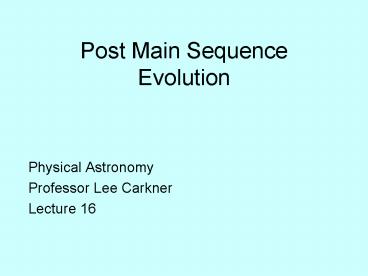Post Main Sequence Evolution - PowerPoint PPT Presentation
1 / 16
Title:
Post Main Sequence Evolution
Description:
Post Main Sequence Evolution. Physical Astronomy. Professor ... Post Main Sequence. As a star evolves off of the main sequence, the surface properties change ... – PowerPoint PPT presentation
Number of Views:165
Avg rating:3.0/5.0
Title: Post Main Sequence Evolution
1
Post Main Sequence Evolution
- Physical Astronomy
- Professor Lee Carkner
- Lecture 16
2
Post Main Sequence
- As a star evolves off of the main sequence, the
surface properties change - This in turn changes the luminosity
- Exact path depends on mass
- Tends to follow pattern of up and to the right
followed by down and to the left
3
Subgiant
- The shell adds more He to the core until it
exceeds the Schonberg-Chandrasekhar limit - This energy expands the atmosphere and the
surface cools - Move to the right along the subgiant branch (SGB)
4
Red Giant
- This increases energy production and the energy
expands the atmosphere further - Star moves up along the red giant branch (RGB)
5
Dredge Up
- As the star evolves along the red giant branch,
the convective zone deepens - This causes a lot of mixing in the star and the
products of the fusion reactions move towards the
surface - We see more He and less Li in the photosphere
6
Helium Ignition
- The H burning shell gets pushed out and actually
decreases in luminosity - Star moves down and left on HR diagram
7
Helium Flash
- For solar mass stars the He burning phase is very
fast - Triple alpha very strongly temperature dependant
- In the very dense core, the energy from the start
of triple alpha cause the next wave of reactions
to speed up - Much energy goes into lifting electron degeneracy
and so we dont see it - After this the core will expand and slow reaction
rate
8
Asymptotic Giant
- After the He core stops burning, the star has an
inert He core and an active He shell - Just like the RGB the star moves up on the HR
diagram - Expanding atmosphere increase luminosity
- Also increases convection producing a second
dredge up
9
Thermal Pulse
- As the star goes up the AGB, the H burning shell
drops He on the He burning shell - The flash pushes the H shell out, slowing the
generation of He - These thermal pulses cause the atmosphere to
expand and contract, altering the luminosity
rapidly
10
AGB Mass Loss
- These thermal pulses can throw material off the
star - Since the outer atmosphere is very cool, dust
grains form in the ejecta - The cores of the stars are now filled with C and
O - Due to the mass loss, stars less than 8 Msun
cant overcome degeneracy - Carbon, oxygen, neon,
- Stars less than 4 Msun will have carbon-oxygen
cores
11
Light Pressure
- For fully absorbing dust grains, the light
pressure is approximately - Prad F/c
- F sT4 at the stellar surface
12
Post-AGB
- Mass loss rates 10-4 Msun/year
- Called OH/IR sources
- OH molecules produce masers
- IR from the dust
13
PN Formation
- Forms planetary nebula
- Core has no more nuclear reactions and forms
white dwarf
14
Planetary Nebula
- We can see the planetary nebula as a fuzzy ball
- White dwarf emits a lot of UV light that excites
or ionizes gas - Gas is very thin so PNs emit forbidden lines
- Makes PNs look green
15
PN Structure
- We would expect PNs to be spherical
- Can get high resolution images with HST
- Gas may be preferentially ejected along equator
or focused by magnetic fields - PNs are expanding at 10-30 km/s
16
Next Time
- Stellar talks
- Be prepared to give talks and ask questions
- For Monday
- Read 15.1-15.3
- Homework 15.2, 15.6, 15.8, 15.11































